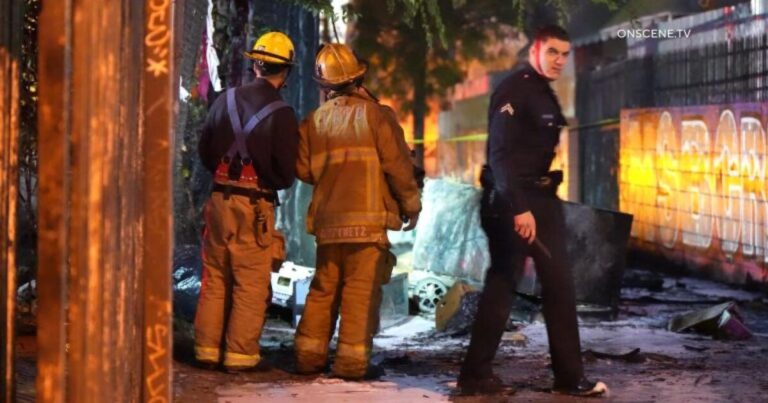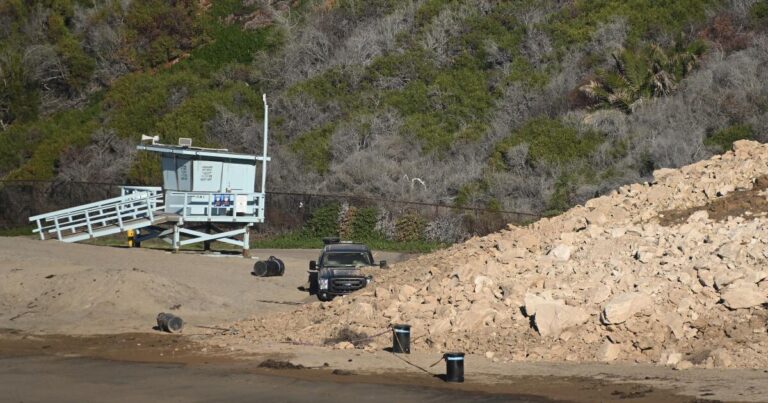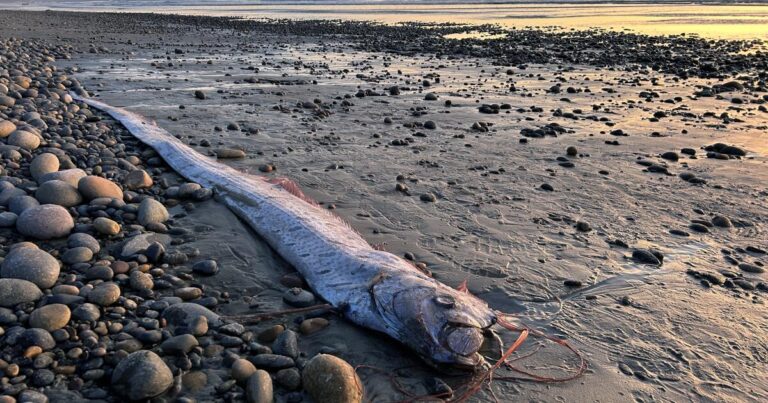If one oarfish landing on a beach is a sign of a disaster to come, how bad will it be if three wash up in quick succession?
A silvery 10-foot-long creature, the oarfish has fueled fisherman’s tales of sea serpents — and in some cultures has been a portent of natural disasters.
It’s rare to see an oarfish up close in California; only 22 have washed ashore since 1901, according to UC San Diego’s Scripps Institution of Oceanography. But in the last three months, three of them have surfaced on Southern California beaches.
The latest was on Nov. 6, when an oarfish was discovered at Grandview Beach by Alison Laferriere, a doctoral candidate at Scripps Institution of Oceanography. The other two beached in La Jolla and Huntington Beach.
The last time a series of oarfish came ashore in California and other parts of the world was over several months in 2013 and 2014. Misty Paig-Tran, associate professor of biological science at Cal State Fullerton, studied four of them.
Every time an oarfish makes an appearance on the sand, it’s a spectacle for scientists as well as the general public for several reasons.
To start with, nobody is expecting a behemoth that’s up to 25 feet long to come so close to the California coast, said Paig-Tran.
“What’s special about them is that when they’re freshly dead or just about to die and you look at their skin, it actually [looks] like a mirror,” she said.
Its length combines with its silver skin and bright red scarlet fins to give it a mythical look.
Since the 1500s, sailors have told of sea monsters as long as their ships, and have even drafted maps that warned of areas in the ocean where such creatures resided. Their depictions appear to describe oarfish.
Oarfish generally live in the upper layers of the ocean depths, from about 300 feet to almost 3,000 feet underwater. Scientists call this section of the ocean the “twilight zone” because the fish that inhabit it are basically living in darkness with only a small glimpse of light, Paig-Tran said.
The twilight zone is too deep for divers to reach and explore, adding to the allure of this species.
If an oarfish happens to swim up to the ocean’s surface, a sailor would see a long slithering creature with spiky protrusions on its head and could believe it was a sea monster, Paig-Tran said.
For the record:
3:17 p.m. Nov. 21, 2024An earlier version of this article said oarfish are bottom feeders. They are filter feeders.
It’s a jarring sight, but oarfish are anything but dangerous. Oarfish are filter feeders, meaning they primarily feed on krill (a small shrimp-like creature) using powerful mouths shaped liked vacuum nozzles, according to Scripps.
An oarfish’s body is extremely delicate, so much so that if you pick one up it could break in half because of its jelly-like bones, Paig-Tran said.
Another factor that adds to the mystique of this creature is the lack of knowledge about its history and daily life, including how it mates, when it lays eggs, what its movement patterns are and how often it feeds.
Scientists are able to study the creatures only when they wash up on a beach.
“When a body comes up, we can do our best to look to the biology and the physiology and try to make our best guesses, but we don’t get to see it living in its natural environment,” Paig-Tran said. “It’s a completely open-ended question of what’s going on with these fishes.”
Why are dead oarfish washing ashore?
Scientists don’t know why these oarfish have died and washed ashore.
The latest oarfish spotted in Encinitas was recovered by a team from the National Oceanic and Atmospheric Administration Fisheries and transported to Southwest Fisheries Science Center, where it will undergo a necropsy so researchers can learn more about the biology, anatomy, genomics and life history of oarfish, according to Scripps.
The deaths of the three fish that have surfaced “may have to do with changes in ocean conditions and increased numbers of oarfish off our coast,” said Ben Frable, manager of Scripps’ marine vertebrate collection.
“Sometimes it may be linked to broader shifts, such as the El Niño and La Niña cycle, but this is not always the case,” he said.
There was a weak El Niño earlier this year, and this wash-up coincided with the recent red tide and Santa Ana winds last week. But many other factors could have played a role in these strandings, Frable added.
Another possible explanation is that the oarfish got stuck in a current and couldn’t go back down into deeper waters.
Oarfish aren’t strong swimmers. They primarily rely on their dorsal fin, whereas strong swimmers use their caudal fin, or back tail, Paig-Tran said.
An oarfish that gets caught in a current and is taken up to the surface doesn’t have a good way to get back down.
“If you are a fish that lives in the deep and you got stuck on the surface, you’re kind of hosed,” she said.
Where did the ‘doomsday’ name come from?
Oarfish have been dubbed “doomsday” fish because some cultures consider it a bad sign when they appear. The moniker is derived from a manipulation of Japanese folklore that became popular following the 2011 earthquake and tsunami in eastern Japan that led to the Fukushima nuclear plant meltdown, Frable said.
“In the two years prior to the disaster, about a dozen oarfish washed up in Japan, most hundreds of miles away from this area,” he said.
In the aftermath of the disaster, people latched onto these strandings as an omen.
This prompted researchers in Japan in 2019 to test whether oarfish and other deep-sea animal strandings were correlated with earthquakes, tsunamis and other factors.
“They found no correlation whatsoever,” Frable said. “But the name is too evocative to disappear.”
On the other hand, Paig-Tran said there could be some truth to the myth, because when an earthquake occurs, it releases pressure that can change a current underwater.
“When the pressure gets released, it changes the currents that [the fish are] living in, and it brings them up to the surface with this kind of big bolus of air and gasses and whatever the turbulence [is] from this earthquake,” she said.
So, are the oarfish that surfaced in Southern California a harbinger of a massive earthquake? According to Paig-Tran: probably not.













